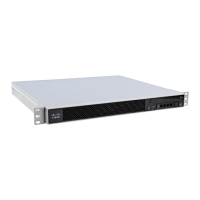17-7
Cisco ASA Series Firewall CLI Configuration Guide
Chapter 17 Quality of Service
Configure QoS
The tx-ring-limit that you specify affects both the higher priority low-latency queue and the best-effort
queue.
Examples
The following example establishes a priority queue on interface “outside” (the GigabitEthernet0/1
interface), with the default queue-limit and tx-ring-limit:
hostname(config)# priority-queue outside
The following example establishes a priority queue on the interface “outside” (the GigabitEthernet0/1
interface), sets the queue-limit to 260 packets, and sets the tx-ring-limit to 3:
hostname(config)# priority-queue outside
hostname(config-priority-queue)# queue-limit 260
hostname(config-priority-queue)# tx-ring-limit 3
Configure a Service Rule for Priority Queuing and Policing
You can configure priority queuing and policing for different class maps within the same policy map.
See How QoS Features Interact, page 17-3 for information about valid QoS configurations.
Before You Begin
• You cannot use the class-default class map for priority traffic.
• (ASASM) The ASASM only supports policing.
• For policing, to-the-box traffic is not supported.
• For policing, traffic to and from a VPN tunnel bypasses interface policing.
• For policing, when you match a tunnel group class map, only outbound policing is supported.
• For priority traffic, identify only latency-sensitive traffic.
• For policing traffic, you can choose to police all other traffic, or you can limit the traffic to certain
types.
Procedure
Step 1 Create a class map to identify the traffic for which you want to perform priority queuing.
class-map priority_map_name
Example:
hostname(config)# class-map priority_traffic
Step 2 Specify the traffic in the class map.
match parameter
Example:
hostname(config-cmap)# match access-list priority
See Identify Traffic (Layer 3/4 Class Maps), page 11-13 for more information.
Step 3 Create a class map to identify the traffic for which you want to perform policing.

